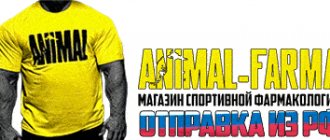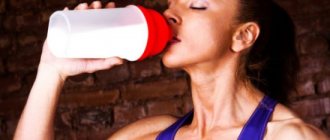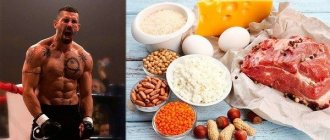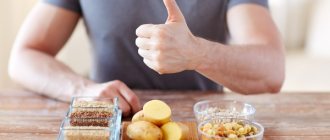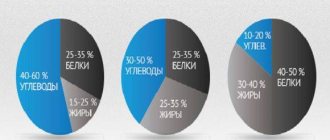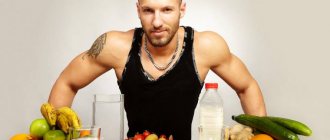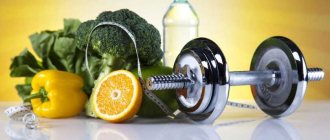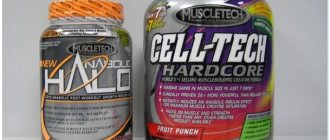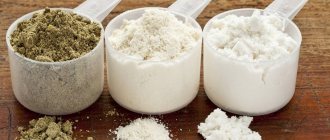- August 31, 2018
- Diets for beauty
- Valeria Bo
Unless the lazy one knows now that protein is a building material for muscle fibers. Entire lectures from trainers are devoted to this topic, or rather the protein diet for gaining muscle mass.
Protein in the diet is necessary for those who want to build muscle mass, thereby increasing their weight precisely through muscle, and not through fat. This article will talk about what a protein diet for gaining muscle mass looks like, menus and recommendations for following it.
How it works?
A protein diet for gaining muscle mass works by consuming large amounts of protein, compared to carbohydrates and especially fats. Lack of protein in the body leads to depletion of muscle fibers, and in more severe forms – to dystrophy.
By consuming foods high in this substance before training, you can achieve muscle growth. Athletes whose goal is to build huge muscle mass consume protein from the sports nutrition series. Although most scientists repeatedly say that protein powder is very harmful to health.
However, a protein diet does not involve eating only protein foods. Fats and carbohydrates are also necessary, but in smaller quantities.
A protein diet should be accompanied by exercise. This is the only way muscle mass will begin to grow. There are several basic rules regarding physical activity:
- Fans of cardio exercises should know that exercises in this category increase muscle endurance, but do not affect their growth in any way.
- Fitness training done in groups, as well as stretching, Pilates, yoga, etc. will not increase muscle volume.
- Light weights (dumbbells, barbells, etc.) will not lead to the desired result.
- But strength exercises that involve several muscle groups are what leads to muscle growth. And sports trainers and equipment must have weights of such weight that more than 7-10 repetitions are practically insurmountable.
Training should be carried out 3-4 times a week. Rest is necessary, since 48 hours are allotted for recovery and growth. In between workouts, protein nutrition and rest should be practiced.
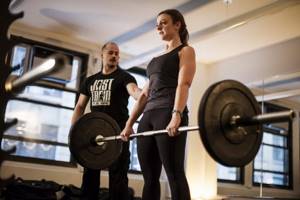
Products recommended for mass gain
When composing your diet, keep in mind that foods are not exclusively protein or carbohydrate. The list below only shows which components the product contains more of.
Protein products
The most protein is found in these foods:
- meat, poultry;
- fish, seafood;
- fruits and vegetables;
- nuts and seeds;
- eggs;
- dairy products (low fat).
Carbohydrate-rich foods
Carbohydrates in foods, as already mentioned, are slow and fast. The former are recommended for daily consumption, the latter are suitable for replenishing energy reserves after exercise.
Low glycemic index foods include:
- cereals, with the exception of semolina;
- legumes;
- pasta (durum wheat);
- wholemeal bread;
- low-sugar fruits (kiwi, peaches, grapefruits, pears, apples, oranges);
- vegetables;
- mushrooms.
Sources of fast carbohydrates:
- products made from premium flour (buns, pizza);
- sugar and honey;
- confectionery;
- sweet fruits.
Fats in the diet
When compiling a diet of protein and carbohydrate foods, the required amount of fat accumulates on its own. If you still need to add them, vegetable oil is quite suitable for this purpose. Additionally, it is recommended to take omega-3 fatty acids during the diet.
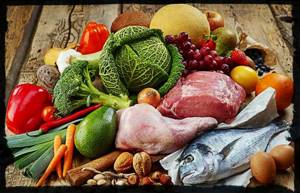
What should a protein diet menu consist of to gain muscle mass?
Muscle-building foods are not only rich in protein, but also in fats and carbohydrates. Therefore, you can stay on such a diet for a long time without harm to your health.
Using this method of nutrition, you can not build muscle, but simply “dry out”, that is, remove fat layers and define muscle definition. For this purpose, you will need six meals a day, and the portions should be small.
But if the goal is muscle growth, then with six meals a day the serving size should be increased, with an emphasis on protein.
At the same time, do not forget to maintain a water regime, that is, consume at least 2.5 liters of clean water per day. This should be drinking water or still mineral water. But juices, sodas, coffee, sweet teas, etc. should be completely excluded.
When compiling the KBJU, athletes who build muscle must adhere to the rule: 70% is protein food, and the remaining 30% consists of carbohydrates and fats.
And now, in fact, what a high-protein diet should consist of to gain muscle mass:
- skim cheese;
- boiled egg whites;
- raw eggs;
- boiled or steamed poultry meat (chicken or turkey), in which case it is necessary to consume exclusively skinless brisket;
- squid carcasses;
- lean sea fish;
- beans;
- various nuts.
The listed products should be consumed for dinner or as an evening snack. As for the morning and lunch meals, the emphasis is on the following products:
- Kefir.
- Natural yoghurt without aromatic and flavoring additives.
- Oatmeal and buckwheat porridges cooked exclusively in water without butter, salt or sugar.
- Vegetables and fruits, but not such as grapes, bananas, pears and potatoes. It is allowed to eat carrots, cabbage of various varieties, cucumbers, tomatoes, bell peppers, plums, apricots, citrus fruits and green apples.
All of the listed products should make up the daily diet of a person who wants to increase in volume due to muscles.
List of permitted and prohibited products
Products recommended for mass gain include:
- Porridge: buckwheat, oatmeal, rice, pearl barley, millet. The exception is semolina - its use is useless;
- Meat: chicken, lean pork, lean beef, turkey, rabbit. It is best to boil or steam;
- Fish. In terms of protein, it is also useful to consume common freshwater species: bream, roach, carp, pike perch, pike; but to provide the body with essential Omega-3 fats, you should pay attention to sea varieties: mackerel, herring, salmon, salmon;
- Eggs. We boil, fry, prepare omelettes and add to cocktails. Contains a large number of essential amino acids. In their raw form they are useless, because... almost not absorbed.
- Milk and products made from it: cottage cheese, cheese, kefir, yogurt.
- Nuts: walnuts, hazelnuts, peanuts;
- Seeds: sunflower and pumpkin;
- Seafood: shrimp, squid, etc.
- Pasta made from durum wheat. Cheap brands are not recommended as they usually contain white wheat flour;
- Vegetables and fruits. The bigger, the better. Helps digest protein and has a positive effect on the digestion process;
- Water. Minimum 2.5 liters of clean water per day. The human body, including muscles, mostly consists of water, and its lack leads to slower growth processes.
It is prohibited to use:
- Fast food: hot dogs, hamburgers, pies, chips, crackers;
- Sweet and flour: cakes, sweets, buns, white bread, carbonated drinks;
- Sausages and store-bought meat products;
- Canned food;
- Alcohol and cigarettes. Not because it is harmful, but because it inhibits the increase in muscle mass.
There are exceptions to these rules. There are people who, no matter how much they eat the right food, still cannot gain weight - in such cases, eating a small amount of sweets is allowed. And those who cannot live without their favorite cake can eat it for breakfast - this is acceptable in the first half of the day.
Protein products
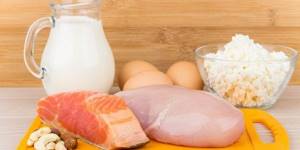
The most popular source of protein among athletes is chicken - inexpensive, tasty, accessible, and quickly digestible. In second place, chicken eggs are a great option for breakfast. 1 egg contains 6 g of protein, which, given the affordable price, will perfectly complement the diet. Cottage cheese is processed by the body for about 6 hours, and all this time it supplies the muscles with protein, so it is better to eat it before bed. You should allow yourself sea fish at least once a week: the value of Omega-3, which is part of it, is difficult to overestimate. Milk is an excellent source of liquid protein and a favorite drink in strength sports. If milk is poorly digested, you can try replacing it with kefir, fermented baked milk or yogurt.
Products containing carbohydrates
Porridge is the best source of carbohydrates for weight gain. Cereals contain so-called slow “coals”, which release energy within 2-3 hours. A good portion of oatmeal is recommended for breakfast, and buckwheat or rice throughout the day. Porridge is needed to replenish energy reserves after a hard workout, for recovery, and also for the functioning of the body during the day. Sweet and flour products contain “fast” carbohydrates, their consumption leads to the formation of fat deposits.
Fats
When an athlete says that there are fats in his diet, he does not mean unhealthy, fatty foods. Healthy fats are found in nuts, seeds and fish. An excellent source of Omega-3 is flaxseed oil, obtained by cold pressing the seeds. You can use fish oil or special supplements obtained from natural raw materials. But the main source of fat is sea fish: mackerel, herring, salmon.
How to properly prepare permitted foods?
The protein diet menu for gaining muscle mass for girls and men should not only consist of the right products presented earlier, but also include their proper preparation. And this point is also accompanied by a number of rules that simply must be followed:
- There should be no fried food. This is a taboo for athletes. Only cooking and only steamed food. It is also possible to bake vegetables and meat in foil in the oven, but without oil.
- A moratorium has also been imposed on salt and sugar. Although this is not scary, since food high in protein has its own taste, which does not spoil the blandness.
- When it comes to salad dressings, you should avoid oil. It is replaced with special yogurt for salad. But still, a couple of tablespoons of olive oil per day, as a salad dressing, is not forbidden.
- You can and should eat before bed. The “don’t eat after 6 pm” rule doesn’t work in a protein diet. 3-4 hours before bedtime, protein will not only be useful, but also easily digestible.
- Fats consumed in food should be healthy. That is, those found in nuts.
- Only complex carbohydrates. You need to forget about the empty ones once and for all.
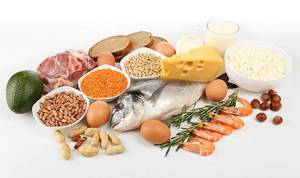
Distribution of protein foods over time
It would seem that there could be something new here: breakfast, lunch and dinner, what else can be added? But, as it turned out, the diet for getting rid of extra pounds and the diet for gaining muscle mass differ in the time and number of meals. And although the latter is less harmful than the first, its duration should not exceed 30 days.
First of all, those who want to build muscle must remember that the number of calories per day should not be less than 2800 kcal. Moreover, you need to achieve such indicators gradually, that is, if previously your norm was 1800 kcal per day, then you need to reach 2800 gradually, adding 300 kcal to your diet daily.
70% of meals, namely breakfast, lunch, snack and afternoon snack, should be consumed in the first half of the day, before 4 pm. And then you need to do the following:
- A couple of hours before training, it will be enough to eat 1 egg white and a small portion of 100 grams of boiled cereal (preferably rice, buckwheat or oatmeal).
- As soon as your workout is over, you will need to drink a protein shake.
- 2-3 hours after training, it’s time for dinner, which will be represented exclusively by foods that contain a lot of protein.
As soon as the time of adhering to the diet passes, the diet will need to be expanded:
- Bakery and pasta products are introduced into the diet at a slow pace, but not made from wheat flour.
- Fruits that are prohibited during a protein diet, as well as vegetables, can be introduced into the diet only a week after the end of the diet.
- 14-21 days after finishing the protein diet, fried foods and confectionery products can be introduced into the menu, but in small quantities.
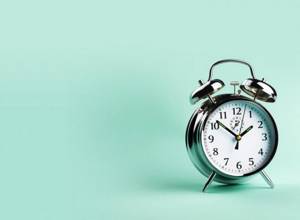
Fully or partially limited products
A protein diet for athletes excludes from the diet:
- White (wheat) bread, pastries, semolina, products made from all types of dough, waffles, cakes, pastries, pancakes, cookies, dumplings, dumplings.
- Sausages, fatty red meats, canned food, animal fats, smoked meats, goose meat, duck meat, semi-finished products, products, fast food products containing food additives.
- Sugar, condensed milk, chocolate, jam, sweets, ice cream, honey, jam, dried fruits (figs, dates, prunes, raisins, dried apricots), sweet desserts.
- Alcoholic, caffeinated and carbonated drinks.
Table of prohibited products
| Proteins, g | Fats, g | Carbohydrates, g | Calories, kcal | |
Vegetables and greens | ||||
| radish | 1,2 | 0,1 | 3,4 | 19 |
| white radish | 1,4 | 0,0 | 4,1 | 21 |
| red radish | 1,2 | 0,1 | 3,4 | 20 |
| black radish | 1,9 | 0,2 | 6,7 | 35 |
| spinach | 2,9 | 0,3 | 2,0 | 22 |
| sorrel | 1,5 | 0,3 | 2,9 | 19 |
Fruits | ||||
| bananas | 1,5 | 0,2 | 21,8 | 95 |
Berries | ||||
| grape | 0,6 | 0,2 | 16,8 | 65 |
Mushrooms | ||||
| mushrooms | 3,5 | 2,0 | 2,5 | 30 |
Nuts and dried fruits | ||||
| raisin | 2,9 | 0,6 | 66,0 | 264 |
Snacks | ||||
| potato chips | 5,5 | 30,0 | 53,0 | 520 |
Cereals and porridges | ||||
| semolina | 10,3 | 1,0 | 73,3 | 328 |
| white rice | 6,7 | 0,7 | 78,9 | 344 |
Flour and pasta | ||||
| pasta | 10,4 | 1,1 | 69,7 | 337 |
| pancakes | 6,3 | 7,3 | 51,4 | 294 |
Bakery products | ||||
| buns | 7,2 | 6,2 | 51,0 | 317 |
Confectionery | ||||
| jam | 0,3 | 0,2 | 63,0 | 263 |
| jam | 0,3 | 0,1 | 56,0 | 238 |
| candies | 4,3 | 19,8 | 67,5 | 453 |
| pastry cream | 0,2 | 26,0 | 16,5 | 300 |
| cookie | 7,5 | 11,8 | 74,9 | 417 |
| dough | 7,9 | 1,4 | 50,6 | 234 |
| halva | 11,6 | 29,7 | 54,0 | 523 |
Ice cream | ||||
| ice cream | 3,7 | 6,9 | 22,1 | 189 |
Cakes | ||||
| cake | 4,4 | 23,4 | 45,2 | 407 |
Chocolate | ||||
| chocolate | 5,4 | 35,3 | 56,5 | 544 |
Raw materials and seasonings | ||||
| mustard | 5,7 | 6,4 | 22,0 | 162 |
| mayonnaise | 2,4 | 67,0 | 3,9 | 627 |
Dairy | ||||
| milk 3.6% | 2,8 | 3,6 | 4,7 | 62 |
| milk 4.5% | 3,1 | 4,5 | 4,7 | 72 |
| cream | 2,8 | 20,0 | 3,7 | 205 |
| sour cream 25% (classic) | 2,6 | 25,0 | 2,5 | 248 |
Cheeses and cottage cheese | ||||
| cheese | 24,1 | 29,5 | 0,3 | 363 |
| cottage cheese 18% (fat) | 14,0 | 18,0 | 2,8 | 232 |
Meat products | ||||
| fatty pork | 11,4 | 49,3 | 0,0 | 489 |
| pork liver | 18,8 | 3,6 | 0,0 | 108 |
| pork kidneys | 13,0 | 3,1 | 0,0 | 80 |
| pork fat | 1,4 | 92,8 | 0,0 | 841 |
| salo | 2,4 | 89,0 | 0,0 | 797 |
| beef liver | 17,4 | 3,1 | 0,0 | 98 |
| beef kidneys | 12,5 | 1,8 | 0,0 | 66 |
| beef brains | 9,5 | 9,5 | 0,0 | 124 |
| bacon | 23,0 | 45,0 | 0,0 | 500 |
Sausages | ||||
| smoked sausage | 16,2 | 44,6 | 0,0 | 466 |
| smoked sausage | 9,9 | 63,2 | 0,3 | 608 |
| sausages | 10,1 | 31,6 | 1,9 | 332 |
| sausages | 12,3 | 25,3 | 0,0 | 277 |
Bird | ||||
| smoked chicken | 27,5 | 8,2 | 0,0 | 184 |
| duck | 16,5 | 61,2 | 0,0 | 346 |
| smoked duck | 19,0 | 28,4 | 0,0 | 337 |
| goose | 16,1 | 33,3 | 0,0 | 364 |
Fish and seafood | ||||
| smoked fish | 26,8 | 9,9 | 0,0 | 196 |
| salted fish | 19,2 | 2,0 | 0,0 | 190 |
| Red caviar | 32,0 | 15,0 | 0,0 | 263 |
| black caviar | 28,0 | 9,7 | 0,0 | 203 |
| canned fish | 17,5 | 2,0 | 0,0 | 88 |
| cod (liver in oil) | 4,2 | 65,7 | 1,2 | 613 |
Oils and fats | ||||
| creamy margarine | 0,5 | 82,0 | 0,0 | 745 |
| vegetable-fat spread | 0,0 | 40,0 | 0,0 | 360 |
| animal fat | 0,0 | 99,7 | 0,0 | 897 |
| cooking fat | 0,0 | 99,7 | 0,0 | 897 |
Non-alcoholic drinks | ||||
| instant coffee dry | 15,0 | 3,5 | 0,0 | 94 |
| Pepsi | 0,0 | 0,0 | 8,7 | 38 |
| sprite | 0,1 | 0,0 | 7,0 | 29 |
| * data is per 100 g of product | ||||
Protein diet menu for gaining muscle mass for men
A protein diet is especially loved by men, since a “mountain” of muscles undoubtedly attracts the attention of the opposite sex, and also gives strength and self-confidence.
This “masculine” diet involves consuming more calories and exercising more intensely. And there is no way to do this without the correct calculation of the KBZHU.
Calories are calculated using the following formula: the man’s current weight (kg) is multiplied by the indicator (K). The latter depends on the metabolic rate: slow - 33, fast - 35. For example, if the weight is 80 kg and the K indicator is fast, then 80 × 35, you get 2800 kcal. But this indicator is not final. This result must also be multiplied by 1.2 (energy reserve). The result is 3,360 kcal - a man needs to consume daily to build muscle.

Menu for the week
And now a sample protein diet menu for gaining muscle mass for men for a week:
- Breakfast: an omelet consisting of a couple of eggs, 1 banana, a couple of slices of black bread. Or: 1 pear, oatmeal, cocoa and 30 g of dark chocolate. You can also: 1 apple, 100 grams of 9% cottage cheese and 50 g of oatmeal porridge.
- First snack: 1 banana, peanuts, protein and rye bread before training. Alternative option: low-fat or 1% kefir, cheese and a slice of black bread.
- For lunch: soups with pure beef broth, baked or boiled chicken breast, 150 g of vegetable salad, sugar-free compote and boiled buckwheat. Another option: turkey meat, low-fat milk, 100 g of boiled white rice. Meat can be replaced with boiled eggs.
- Snack No. 2 (post-workout): 2 bananas and 4-5 pieces of dark chocolate or 100 g of dried fruits and 50 g of nuts. Alternative: apple, a couple of yolks and 4 whites, plus 50 g of almonds.
- Protein dinner: 200 g of boiled or baked fish, an orange or a cup of green unsweetened tea. Second option: mashed potatoes (100 grams), boiled veal, stewed vegetables and 1 banana.
The consumption of protein shakes cannot be ruled out, especially before and after workouts. You can replace cocktails with soy meat, low-fat kefir, various types of cheese (tofu, Mozzarella), low-fat cottage cheese and yoghurt.
Fanaticism when following a protein diet menu to gain muscle mass for men is unnecessary. Only 2 g of protein per kg of weight will be enough to gain muscle volume, and 1.5 g of protein will be enough to maintain it.
And water. Don't forget to stay hydrated.
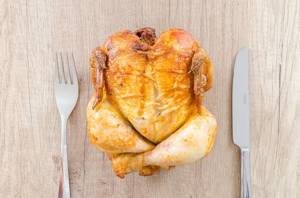
Diet for girls
The protein diet menu for gaining muscle mass for girls every day is somewhat different from that for men. Although for women, eating protein foods should be associated with intense training.
Since women tend to quickly gain extra pounds, compared to men, there is no need to rush to gain these pounds. Because the percentage of body fat will be higher, and more intense training will be required to burn it.
Therefore, in order for a protein diet for gaining muscle mass for girls to lead to a flat stomach and sculpted, pumped up (but not over-pumped) muscles, the weight gain should be smooth, without jumps.
The amount of BJU in a girl’s diet differs from that of men. The ratio should be as follows: 40% protein, 40% carbohydrates and only 20% fat.

Calorie calculation
Any muscle-building diet is based on the principle “you need to get more than you spend.” We are talking about calorie intake.
The daily norm of kilocalories needed by a person is calculated using the formula: weight (kg) × 30 = kcal
The result obtained by this method of calculation is approximate. For a more accurate calculation, use the Harris-Benedict formula. Calculations are carried out in several stages.
First, calculate the metabolic rate (hereinafter abbreviated as MT):
- For men: UM = 88.362 + (13.397 x weight/kg) + (4.799 x height/cm) – (5.677 x full years);
- Women: UM = 447.593 + (9.247 x weight/kg) + (3.098 x height/cm) – (4.330 x age).
The next step is to determine the coefficient according to the level of physical activity and calculate the daily calorie intake:
| Number of workouts per week | Coefficient for calculating kilocalories per day |
| None | UMx 1.20 |
| 1–3 | UM x 1.37 |
| 3–5 | UMx 1.55 |
| 6–7 | UM x 1.72 |
| 2 | UM x 1.90 |
If you do not go beyond the obtained result, your body mass index will remain approximately at the same level. But we are interested in the right diet for gaining muscle mass. This means that additional building material and energy are needed. We add 500-1000 Kcal to the total calorie content of the daily diet, depending on the body type.
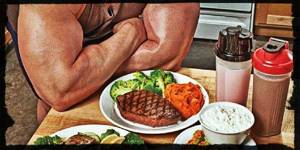
Menu Rules
The eating process is divided into 5-6 times a day. But before 4 pm you just need to consume 3/4 of your total daily ration.
- Empty carbohydrates, namely: pastries, juices, etc. are allowed after training, but their amount should be negligible.
- 8 glasses of water per day is the necessary norm that a girl must follow.
- Vegetables and fruits are eaten in small quantities, as they interfere with the absorption of protein.
- A complex of vitamins is necessary to dilute the menu of a protein diet to gain muscle mass for girls.
- Protein shakes and amino acid capsules are essential for girls.
- Boiling, stewing, baking and steaming are permitted cooking methods.
- All tasty harmful things only lead to cellulite, which is difficult to get rid of.
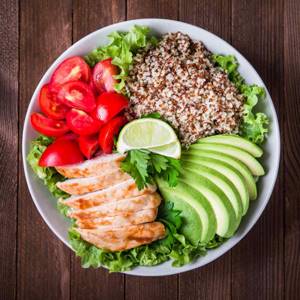
Combination of diet with sports nutrition
Athletes can use any of the diets described either independently or in combination with anabolic steroids or sports nutrition.
Some tips:
- You can and should take vitamin-mineral complexes. Due to the reduced amount of fruits and greens, the risk of vitamin deficiency increases.
- Creatine is taken immediately after training with sweet juice. It can also be mixed with protein or gainers.
- Protein shakes are taken before bed, immediately after waking up, after training or in between meals.
- Anabolic steroids do not affect the composition of the diet, but in combination with it they have a greater effect.

Workout
As for training for girls during a protein diet:
- the break between training should not be less than 48 hours;
- The duration of training is no more than 2 hours;
- increase the weight gradually - the muscles should feel the load little by little;
- 8-10 repetitions in 3-5 sets will be enough;
- the first approach is the most persistent, consisting of 10 repetitions, but the last one will be 6 repetitions;
- change your training plan and type of exercise every 1-1.5 months, otherwise the muscles will get used to it and will not grow.
